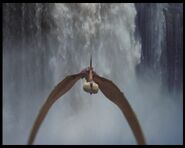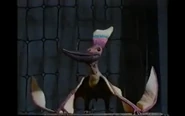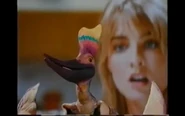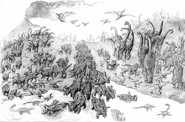| Geosternbergia Temporal range: Late Cretaceous | |
|---|---|

| |
| An artist's illustration of Geosternbergia sternbergi | |
| Scientific classification | |
| Kingdom: | Animalia |
| Phylum: | Chordata |
| Class: | Sauropsida |
| Order: | †Pterosauria |
| Suborder: | †Pterodactyloidea |
| Family: | †Pteranodontidae |
| Genus: | †Geosternbergia Miller, 1978 |
| Referred species | |
| |
| Synonyms | |
| |
"Geosternbergia" is a highly dubious genus of - pterodactyloid pterosaur from the Late Cretaceous geological period of North America. It was one of the largest pterosaur genera and had a wingspan of up to 7.25 meters (23.8 feet). Today almost all scientists agree that it is a species of pteranodon rather then a separate genus.
Description[]
"Geosternbergia" was among the largest pterosaurs, with the wingspan of most adults ranging between 3–6 meters (9.8–19.7 feet). No complete skulls of adult males have been found, but a nearly complete lower jaw has been estimated at 1.25 meters (4.1 feet) long. While most specimens are found crushed, enough fossils exist to put together a detailed description of the animal. "Geosternbergia" sternbergi was very similar to the more well-known pterosaur species Pteranodon longiceps and is currently considered an earlier species of Pteranodon itself.
The most distinctive characteristic of "Geosternbergia" is its cranial crest. These crests consisted of skull bones (frontals) projecting upward and backward from the skull. The size and shape of these crests varied due to a number of factors, including age, gender, and species. Male "Geosternbergia" the older species of the two described to date, had a larger vertical crest with a broad forward projection, Females were smaller and bore small, rounded crests. The crests were probably mainly display structures, though they may have had other functions as well.
Discovery and history[]
The first "Geosternbergia" fossil was collected by George F. Sternberg in 1952 and described by John Christian Harksen in 1966, from the lower portion of the Niobrara Formation. It was older than Pteranodon longiceps and is considered by Bennett to be the direct ancestor of that species.
Classification[]
Geosternbergia is traditionally considered to be a species, or occasionally subgenus, of the similar pterosaur Pteranodon , in most major studies of pteranodontians. In 2010 a review of the group by A.W.A. Kellner suggested that P. sternbergi was different enough from P. longiceps to belong in a distinct genus, to which Kellner also referred a new species, "Geosternbergia maysei", however most paleontologists diagree with this claim. The pterosaur researcher Chris Bennett has suggested that the G. maysei specimen an adult male P. longiceps.
Paleobiology[]
Sexual variation[]
Adult "Geosternbergia" specimens may be divided into two distinct size classes, small and large, with the large size class being about one and a half times larger than the small, and the small being twice as common as the large. Both size classes lived alongside each other, and while researchers had previously suggested that they represent different species, Christopher Bennett showed that the differences between them are consistent with the concept that they represent females and males, and that "Geosternbergia" species were sexually dimorphic. Skulls from the larger size class preserve large, upward and backward pointing crests, while the crests of the smaller size class are small and triangular. Some larger skulls also show evidence of a second crest that extended long and low, toward the tip of the beak, which is not seen in smaller specimens.
The gender of the different size classes was determined, not from the skulls, but from the pelvic bones. Contrary to what may be expected, the smaller size class had disproportionately large and wide-set pelvic bones. Bennett interpreted this as indicating a more spacious birth canal, through which eggs would pass. He concluded that the small size class with small, triangular crests represent females, and the larger, large-crested specimens represent males.
Note that the overall size and crest size also corresponds to age. Immature specimens are known from both females and males, and immature males often have small crests similar to adult females. Therefore, it seems that the large crests only developed in males when they reached their large, adult size, making the gender of immature specimens difficult to establish from partial remains.
The fact that females appear to have outnumbered males two to one suggests that, as with modern animals with size-related sexual dimorphism, such as sea lions and other pinnipeds, "Geosternbergia" might have been polygynous, with a few males competing for association with groups consisting of large numbers of females. Similar to modern pinnipeds, "Geosternbergia" may have competed to establish territory on rocky, offshore rookeries, with the largest, and largest-crested, males gaining the most territory and having more success mating with females. The crests of male "Geosternbergia" would not have been used in competition, but rather as "visual dominance-rank symbols", with display rituals taking the place of physical competition with other males. If this hypothesis is correct, it also is likely that male "Geosternbergia" played little to no part in rearing the young; such a behavior is not found in the males of modern polygynous animals who father many offspring at the same time.
In the Media[]

- Its not physically seen in the The Lost World: Jurassic Park. But its proven to be on the island by Roland’s Dinosaur guide, the trailer’s screensaver, and by several drawings and models made for the film, the animal itself is never physically seen in any scene of the film. It has been suggested that the intended use for this species was to be the male sexually dimorphic version of the Pteranodon longiceps species seen at the very end of The Lost World: Jurassic Park.
- It also appeared in the beginning of Disney's Dinosaur. Despite how is it shown that the female had a crest on its head but can only be founded on males and the females have a very small crest. The babies shown to have crests on their which is a little accurate however in real life, they didn't have crest until they reached adulthood.
- It appeared in the Prehysteria trilogy and was named Madonna despite being a female it is actually a male because of the shape of the crest.
- Geosternbergia also appears in the series, Prehistoric Planet, and features in its own scenes.
- It appears in the Dinosauria series as well, with its own episode dedicated to a small group of them.




























































